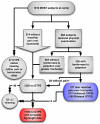Leg-length inequality is not associated with greater trochanteric pain syndrome
- PMID: 18510741
- PMCID: PMC2483453
- DOI: 10.1186/ar2433
Leg-length inequality is not associated with greater trochanteric pain syndrome
Abstract
Introduction: Greater trochanteric pain syndrome (GTPS) is a common condition, the pathogenesis of which is incompletely understood. Although leg-length inequality has been suggested as a potential risk factor for GTPS, this widely held assumption has not been tested.
Methods: A cross-sectional analysis of greater trochanteric tenderness to palpation was performed in subjects with complaints of hip pain and no signs of hip osteoarthritis or generalized myofascial tenderness. Subjects were recruited from one clinical center of the Multicenter Osteoarthritis Study, a multicenter population-based study of community-dwelling adults aged 50 to 79 years. Diagnosis of GTPS was based on a standardized physical examination performed by trained examiners, and technicians measured leg length on full-limb anteroposterior radiographs.
Results: A total of 1,482 subjects were eligible for analysis of GTPS and leg length. Subjects' mean +/- standard deviation age was 62.4 +/- 8.2 years, and 59.8% were female. A total of 372 lower limbs from 271 subjects met the definition for having GTPS. Leg-length inequality (difference > or = 1 cm) was present in 37 subjects with GTPS and in 163 subjects without GTPS (P = 0.86). Using a variety of definitions of leg-length inequality, including categorical and continuous measures, there was no association of this parameter with the occurrence of GTPS (for example, for > or = 1 cm leg-length inequality, odds ratio = 1.17 (95% confidence interval = 0.79 to 1.73)). In adjusted analyses, female sex was significantly associated with the presence of GTPS, with an adjusted odds ratio of 3.04 (95% confidence interval = 2.07 to 4.47).
Conclusion: The present study found no evidence to support an association between leg-length inequality and greater trochanteric pain syndrome.
Figures
References
-
- Bolen J, Helmick C, Sacks J, Langmaid G. Prevalence of self reported arthritis or chronic joint symptoms among adults – United States, 2001. MMWR. 2002;51:948–950. - PubMed
-
- Shbeeb MI, Matteson EL. Trochanteric bursitis (greater trochanter pain syndrome) Mayo Clin Proc. 1996;71:565–569. - PubMed
-
- Frontera WR, Silver JK. Essentials of Physical Medicine and Rehabilitation. Philadelphia: Hanley & Belfus; 2002.
-
- Klippel JH, Dieppe P. Rheumatology. 2. Vol. 1. London and St Louis, MO: Mosby; 1998.
-
- Kelley WN. Textbook of Rheumatology. 4. Philadelphia: WB Saunders; 1993.
Publication types
MeSH terms
Grants and funding
LinkOut - more resources
Full Text Sources
Medical
Miscellaneous


